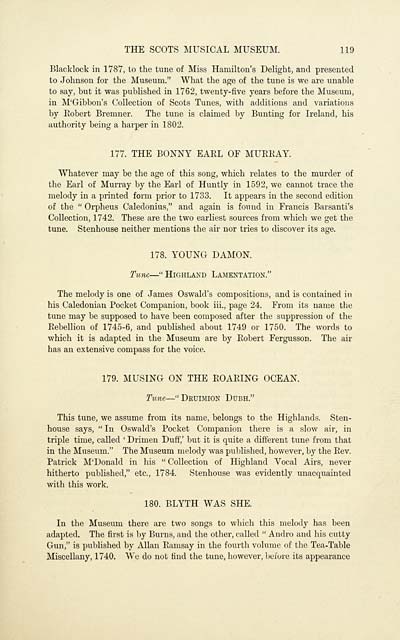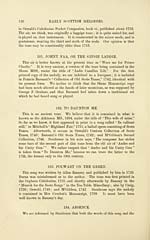Inglis Collection of printed music > Printed text > Early Scottish melodies
(141) Page 119 - Bonny Earl of Murray
Download files
Complete book:
Individual page:
Thumbnail gallery: Grid view | List view

THE SCOTS MUSICAL MUSEUM. 119
Blacklock in 1787, to the tune of Miss Hamilton's Delight, and presented
to Johnson for the Museum." What the age of the tune is we are unable
to say, but it was published in 1762, twenty-five years before the Museum,
in M'Gibbon's Collection of Scots Tunes, with additions and variations
by Eobert Bremner. The tune is claimed by Bunting for Ireland, his
authority being a harper in 1802.
177. THE BONNY EAKL OF MURRAY.
Whatever may be the age of this song, which relates to the murder of
the Earl of Murray by the Earl of Huntly in 1592, we cannot trace the
melody in a printed form prior to 1733. It appears in the second edition
of the " Orpheus Caledonius," and again is found in Francis Barsanti's
Collection, 1742. These are the two earliest sources from which we get the
tune. Stenhouse neither mentions the air nor tries to discover its age.
178. YOUNG DAMON.
Tune — " Highland Lamentation."
The melody is one of James Oswald's compositions, and is contained in
his Caledonian Pocket Companion, book iii., page 24. From its name the
tune may be supposed to have been composed after the suppression of the
Rebellion of 1745-6, and published about 1749 or 1750. The words to
which it is adapted in the Museum are by Robert Fergusson. The air
has an extensive compass for the voice,
179. MUSING ON THE ROARING OCEAN.
Tune — " Druimion Dubh."
This tune, we assume from its name, belongs to the Highlands. Sten-
house says, " In Oswald's Pocket Companion there is a slow air, in
triple time, called ' Drimen Duff,' but it is quite a different tune from that
in the Museum." The Museum melody was published, however, by the Rev.
Patrick M'Donald in his " Collection of Highland Vocal Airs, never
hitherto published," etc., 1784. Stenhouse was evidently unacquainted
with this work.
180. BLYTH WAS SHE.
In the Museum there are two songs to which this melody has been
adapted. The first is by Burns, and the other, called " Andro and his cutty
Gun," is published by Allan Ramsay in the fourth volume of the Tea-Table
Miscellany, 1740. We do not find the tune, however, before its appearance
Blacklock in 1787, to the tune of Miss Hamilton's Delight, and presented
to Johnson for the Museum." What the age of the tune is we are unable
to say, but it was published in 1762, twenty-five years before the Museum,
in M'Gibbon's Collection of Scots Tunes, with additions and variations
by Eobert Bremner. The tune is claimed by Bunting for Ireland, his
authority being a harper in 1802.
177. THE BONNY EAKL OF MURRAY.
Whatever may be the age of this song, which relates to the murder of
the Earl of Murray by the Earl of Huntly in 1592, we cannot trace the
melody in a printed form prior to 1733. It appears in the second edition
of the " Orpheus Caledonius," and again is found in Francis Barsanti's
Collection, 1742. These are the two earliest sources from which we get the
tune. Stenhouse neither mentions the air nor tries to discover its age.
178. YOUNG DAMON.
Tune — " Highland Lamentation."
The melody is one of James Oswald's compositions, and is contained in
his Caledonian Pocket Companion, book iii., page 24. From its name the
tune may be supposed to have been composed after the suppression of the
Rebellion of 1745-6, and published about 1749 or 1750. The words to
which it is adapted in the Museum are by Robert Fergusson. The air
has an extensive compass for the voice,
179. MUSING ON THE ROARING OCEAN.
Tune — " Druimion Dubh."
This tune, we assume from its name, belongs to the Highlands. Sten-
house says, " In Oswald's Pocket Companion there is a slow air, in
triple time, called ' Drimen Duff,' but it is quite a different tune from that
in the Museum." The Museum melody was published, however, by the Rev.
Patrick M'Donald in his " Collection of Highland Vocal Airs, never
hitherto published," etc., 1784. Stenhouse was evidently unacquainted
with this work.
180. BLYTH WAS SHE.
In the Museum there are two songs to which this melody has been
adapted. The first is by Burns, and the other, called " Andro and his cutty
Gun," is published by Allan Ramsay in the fourth volume of the Tea-Table
Miscellany, 1740. We do not find the tune, however, before its appearance
Set display mode to: Large image | Transcription
Images and transcriptions on this page, including medium image downloads, may be used under the Creative Commons Attribution 4.0 International Licence unless otherwise stated. ![]()
| Special collections of printed music > Inglis Collection of printed music > Printed text > Early Scottish melodies > (141) Page 119 - Bonny Earl of Murray |
|---|
| Permanent URL | https://digital.nls.uk/94644964 |
|---|---|
| Description | Also: Young Damon. Also: Musing on the roaring ocean. Also: Blyth was she. |
| Description | Scottish and English songs, military music and keyboard music of the 18th and 19th centuries. These items are from the collection of Alexander Wood Inglis of Glencorse (1854 to 1929). Also includes a few manuscripts, some treatises and other books on the subject. |
|---|
| Description | The Glen Collection and the Inglis Collection represent mainly 18th and 19th century Scottish music, including Scottish songs. The collections of Berlioz and Verdi collected by bibliographer Cecil Hopkinson contain contemporary and later editions of the works of the two composers Berlioz and Verdi. |
|---|

